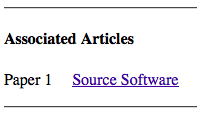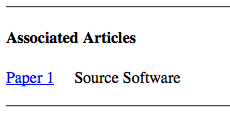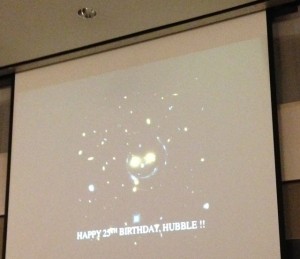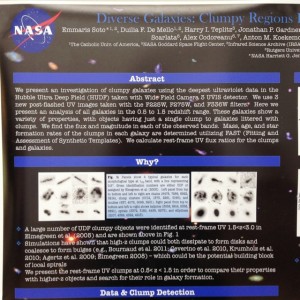In July 2014, the ASCL moved to its current infrastructure; we left the older site up to give those who use the ASCL time to adjust to the new site and change their bookmarks. Now it’s time — some might say high time! — that the previous site be retired. On or about September 4, the old ASCL site, both the WordPress site and the discussion forum housing the code entries, will no longer be accessible. All code entries housed on the old site will redirect to the entries here, and other pages will redirect to ascl.net. If you have questions or concerns about this change, please comment below or email me at aallen@ascl.net. Thank you!
Category Archives: news
Change to the Code Record page
From feedback we received about the “Ref” field, we’ve relabeled that field to lessen the confusion about the article link(s) in the Code Record. What had appeared is:
What now appears is:

We supply a link, too, to a page that explains what the Website, Appears in, and Bibcode fields are, and hope this makes things clearer.
If you have suggestions for the ASCL, please feel free to post them here or email editor@ascl.net. Thank you!
July 2015 additions to the ASCL
Twenty codes were added to the ASCL in July 2015:
3D-Barolo: 3D fitting tool for the kinematics of galaxies
abo-cross: Hydrogen broadening cross-section calculator
Astrochem: Abundances of chemical species in the interstellar medium
AstroStat: Statistical analysis tool
DALI: Derivative Approximation for LIkelihoods
DRAMA: Instrumentation software environment
FAT: Fully Automated TiRiFiC
getsources: Multi-scale, multi-wavelength source extraction
HLINOP: Hydrogen LINe OPacity in stellar atmospheres
IEHI: Ionization Equilibrium for Heavy Ions
K-Inpainting: Inpainting for Kepler
L-PICOLA: Fast dark matter simulation code
Least Asymmetry: Centering Method
Pelican: Pipeline for Extensible, Lightweight Imaging and CAlibratioN
PPInteractions: Secondary particle spectra from proton-proton interactions
pyro: Python-based tutorial for computational methods for hydrodynamics
REDSPEC: NIRSPEC data reduction
slimplectic: Discrete non-conservative numerical integrator
SUPERBOX: Particle-multi-mesh code to simulate galaxies
Toyz: Large datasets and astronomical images analysis framework
The “Ref” field in an ASCL entry
ASCL entries include a field called “Ref,” for “refereed.” As the ASCL indexes codes used in research, this field contains at least one link to a research article which describes a code or in which the code was used.
The information in the Ref field is used by ADS to link papers and the codes they use, making it easy for someone reading an article to find the code(s) used in that research. You can find these associations in the “Associated Articles” section of an ADS entry.
In the first image below, which is a screen clip from an ADS entry, the Source Software link brings up the ASCL entry for a code used in the article; in the second image, the Paper 1 link brings up a paper that used the code:

Some papers have several links in the Ref field:
 These are papers we found while researching a code or were entered by a code author when submitting code to the ASCL. Associating article entries with entries for the codes used in those articles makes finding the software used in the research easier. And though software is increasingly cited (in a variety of ways), it isn’t always, so using the Ref/Associated Articles links can help a code author demonstrate the impact of a particular software package.
These are papers we found while researching a code or were entered by a code author when submitting code to the ASCL. Associating article entries with entries for the codes used in those articles makes finding the software used in the research easier. And though software is increasingly cited (in a variety of ways), it isn’t always, so using the Ref/Associated Articles links can help a code author demonstrate the impact of a particular software package.
I know the ASCL is missing many of these associations; ADS and the ASCL would like to improve this linkage. If you have ideas on how to do this, please post them here, or send them to editor@ascl.net. Thanks!
June 2015 additions to the ASCL
Ten codes were added to the ASCL in June 2015:
dmdd: Dark matter direct detection
EATCVB: Coronal heating rate approximations
fsclean: Faraday Synthesis CLEAN imager
multiband_LS: Multiband Lomb-Scargle Periodograms
PLATO Simulator: Realistic simulations of expected observations
pyKLIP: PSF Subtraction for Exoplanets and Disks
PyMC: Bayesian Stochastic Modelling in Python
REALMAF: Magnetic power spectra from Faraday rotation maps
SPRITE: Sparsity-based super-resolution algorithm
VAPID: Voigt Absorption-Profile [Interstellar] Dabbler
The 3rd DC/MD/VA Summer Astrophysics Meeting
On Thursday, June 25, I attended part of the 3rd annual DC/MD/VA Summer Astrophysics Meeting; duties elsewhere prevented me from attending the whole event, alas. This meeting, which rotates among the sponsoring universities, was held this year at the Catholic University of America in Washington, DC, and is intended for senior undergraduates and graduate students to network, present their work, and facilitate interaction among local institutions. At least ten area universities were represented at the event.
 I arrived in plenty of time to hear keynote speaker Dr. Jennifer Wiseman‘s excellent presentation The Hubble Space Telescope: 25 Years of Science and Discovery; it is always a pleasure to hear her speak.
I arrived in plenty of time to hear keynote speaker Dr. Jennifer Wiseman‘s excellent presentation The Hubble Space Telescope: 25 Years of Science and Discovery; it is always a pleasure to hear her speak.
Next on the agenda were Jeremy Hare from George Washington University, who presented Unveiling the nature of high energy sources using machine learning and Joel Coley from the University of Maryland, Baltimore County, with Probing the long-term variability and eclipsing properties of high-mass X-ray binaries. After a short break, the program continued with a presentation on The science of WFIRST: Gravitational microlensing, the galactic bulge, and the transit method, this originally to be presented by Kathryn Waychoff of Dartmouth College and NASA Goddard Space Flight Center, but given in her absence instead by three of GSFC undergraduate summer interns whose names I unfortunately did not catch* Nyki Anderson, Emily Kilen, and Sean Terry; they did an amazing job. (I kept thinking, “These are summer interns?!?!” They really knew their stuff!)
 My presentation on the ASCL was the last of the day. Only a few people present had heard of the ASCL before this meeting; I was happy for the opportunity to bring the ASCL to this audience. My talk covered what the ASCL is, why it exists, and how it has grown and is used by the community; my PowerPoint presentation (with speaker notes) is available for download.
My presentation on the ASCL was the last of the day. Only a few people present had heard of the ASCL before this meeting; I was happy for the opportunity to bring the ASCL to this audience. My talk covered what the ASCL is, why it exists, and how it has grown and is used by the community; my PowerPoint presentation (with speaker notes) is available for download.
In addition to Thursday afternoon’s presentations, I got a chance to peruse posters and talk with some of the poster presenters. I’m so pleased I could participate, and wish only that I had been able to attend all of it! The future of astrophysics is in good hands. Kudos to the organizers and participants for such an excellent event.
*My thanks to Sean for filling in the blanks for me!
May 2015 additions to the ASCL
Thirty-four codes were added to the ASCL in May 2015:
2dfdr: Data reduction software
ARoME: Analytical Rossiter-McLaughlin Effects
ASteCA: Automated Stellar Cluster Analysis
Athena3D: Flux-conservative Godunov-type algorithm for compressible magnetohydrodynamics
BAYES-X: Bayesian inference tool for the analysis of X-ray observations of galaxy clusters
CALCEPH: Planetary ephemeris files access code
CANDID: Companion Analysis and Non-Detection in Interferometric Data
caret: Classification and Regression Training
COBS: COnstrained B-Splines
cosmoabc: Likelihood-free inference for cosmology
CUTE: Correlation Utilities and Two-point Estimation
dStar: Neutron star thermal evolution code
FCLC: Featureless Classification of Light Curves
fits2hdf: FITS to HDFITS conversion
HALOGEN: Approximate synthetic halo catalog generator
KS Integration: Kelvin-Stokes integration
Lensed: Forward parametric modelling of strong lenses
LSSGALPY: Visualization of the large-scale environment around galaxies on the 3D space
missForest: Nonparametric missing value imputation using random forest
Planck Level-S: Planck Simulation Package
POKER: P Of K EstimatoR
pyMCZ: Oxygen abundances calculations and uncertainties from strong-line flux measurements
PyTransit: Transit light curve modeling
relline: Relativistic line profiles calculation
RESOLVE: Bayesian algorithm for aperture synthesis imaging in radio astronomy
rvfit: Radial velocity curves fitting for binary stars or exoplanets
SCEPtER: Stellar CharactEristics Pisa Estimation gRid
SNEC: SuperNova Explosion Code
Snoopy: General purpose spectral solver
SNooPy: TypeIa supernovae analysis tools
Starfish: Robust spectroscopic inference tools
StellaR: Stellar evolution tracks and isochrones tools
TEA: Thermal Equilibrium Abundances
TFIT: Mixed-resolution data set photometry package
More where the codes are
Here are a few handy links to find astro software, whether used for research or not; some resources required two searches.
BitBucket: astronomy and astrophysics
GitHub
IDL
PyPi: astronomy and astrophysics
R
SourceForge
April 2015 additions to the ASCL
Twenty-one codes were added to the ASCL in April 2015:
abcpmc: Approximate Bayesian Computation for Population Monte-Carlo code
BGLS: A Bayesian formalism for the generalised Lomb-Scargle periodogram
chimenea: Multi-epoch radio-synthesis data imaging
CosmoTransitions: Cosmological Phase Transitions
D3PO: Denoising, Deconvolving, and Decomposing Photon Observations
DPI: Symplectic mapping for binary star systems for the Mercury software package
drive-casa: Python interface for CASA scripting
EsoRex: ESO Recipe Execution Tool
HOTPANTS: High Order Transform of PSF ANd Template Subtraction
IGMtransmission: Transmission curve computation
JWFront: Wavefronts and Light Cones for Kerr Spacetimes
kozai: Hierarchical triple systems evolution
LineProf: Line Profile Indicators
MCSpearman: Monte Carlo error analyses of Spearman’s rank test
MRrelation: Posterior predictive mass distribution
samiDB: A Prototype Data Archive for Big Science Exploration
Self-lensing binary code with Markov chain
SPA: Solar Position Algorithm
SOAP 2.0: Spot Oscillation And Planet 2.0
UPMASK: Unsupervised Photometric Membership Assignment in Stellar Clusters
Closure of Google Code and impact on ASCL records
Google has announced the closure of its Google Code service. Google suggests several courses of action and states, “We … offer stand-alone tools for migrating to GitHub and Bitbucket, and SourceForge offers a Google Code project importer service.”
Please take steps to save your software! If you migrate your code to another site, I would appreciate knowing the new URL. If you are no longer working on your software and do not want to migrate it to another project hosting site, please allow the ASCL to store an archive file (tarball/zip/etc.) of it with the ASCL entry so it remains available to support your written research record, or select another option to preserve your code. If you would like to have the ASCL host an archive file, please contact me; thank you.
